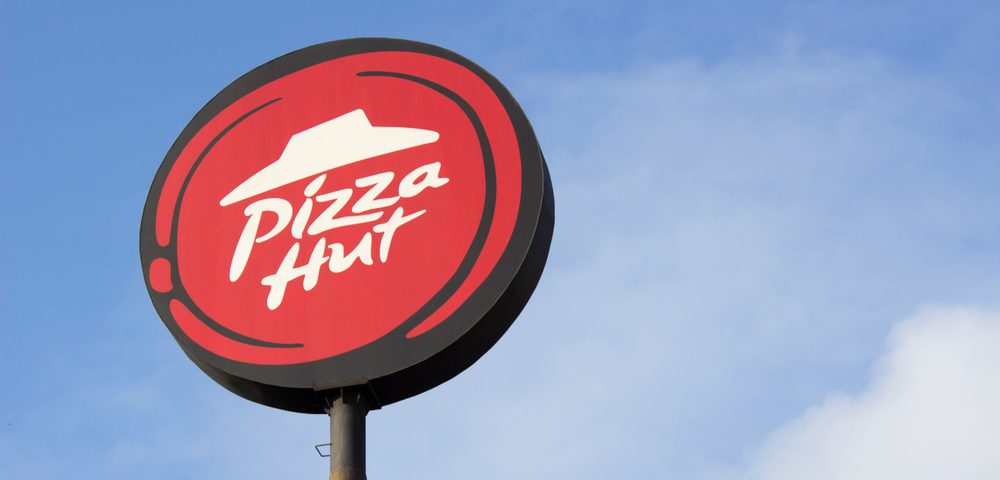
FMS Franchise Europe: Your Gateway to Franchising Success Across the European Market
November 3, 2025
Wingman Planning Celebrates Grand Opening of Its First Franchise Location in Middletown, NJ
November 6, 2025
Few restaurant brands are as universally recognized and deeply woven into global dining culture as Pizza Hut. What began as a small pizza parlor in Kansas in the late 1950s evolved into one of the world’s largest and most successful restaurant franchise systems, spanning more than 19,000 locations across 100+ countries.
The story of Pizza Hut is not just about pizza — it’s a masterclass in entrepreneurship, branding, innovation, and franchising. Through a combination of bold vision, consistent quality, and a scalable franchise model, the company transformed the humble American pizza into a global phenomenon.
The Beginning: A Simple Idea in Wichita, Kansas (1958)
Pizza Hut’s story begins in 1958, in the Midwestern city of Wichita, Kansas. Two brothers, Dan and Frank Carney, were students at Wichita State University when a family friend suggested they open a pizza parlor — a concept still relatively new in America at the time.
With a $600 loan from their mother, the Carney brothers rented a small building on Bluff Street and opened the first Pizza Hut. The name came from the limited space available on the sign outside the building — only enough room for eight letters. Since the building looked like a “hut,” the brothers settled on Pizza Hut, and an iconic brand was born.
Their vision was simple but powerful: serve great-tasting pizza with friendly, reliable service in a clean, family-friendly environment. That customer-centric approach became the cornerstone of Pizza Hut’s brand identity.
Early Growth and the Start of Franchising (1959–1968)
Pizza Hut’s growth was rapid. Within a year of opening, demand for their pizza was so high that the Carneys began exploring ways to expand. Recognizing that franchising could accelerate growth without heavy capital investment, they awarded their first franchise in 1959, just one year after opening.
By 1963, there were 24 Pizza Hut locations, and by 1966, the brand established its first headquarters in Wichita. The company also developed standardized recipes, operational manuals, and marketing materials — laying the groundwork for a consistent, scalable franchise model.
In 1968, Pizza Hut introduced its distinctive red roof restaurant design, an architectural style that soon became one of the most recognizable icons in fast food history. The “Red Roof” locations weren’t just restaurants; they were symbols of reliability, community, and shared family meals.
Going Public and Scaling Nationally (1969–1977)
By the late 1960s, Pizza Hut had grown to 310 restaurants nationwide. The Carney brothers decided to take the company public to fuel further expansion. In 1969, Pizza Hut, Inc. was listed on the New York Stock Exchange, giving it access to the capital it needed to support franchise growth and corporate development.
Throughout the early 1970s, Pizza Hut invested heavily in national advertising, menu innovation, and franchise support systems. The company became synonymous with American family dining, positioning itself not just as a pizza place but as a gathering spot for friends and family.
In 1971, Pizza Hut became the number one pizza chain in the world, with more locations and higher sales than any of its competitors. By 1977, it had grown to more than 4,000 restaurants, with a presence in every major U.S. city.
That same year, the Carney brothers sold Pizza Hut to PepsiCo, marking the beginning of a new era of global expansion.
The PepsiCo Era and International Expansion (1977–1997)
Under PepsiCo’s ownership, Pizza Hut gained access to unprecedented marketing, distribution, and operational resources. The partnership enabled Pizza Hut to accelerate its international franchise growth, tapping into PepsiCo’s global logistics and branding network.
Global Growth
In the late 1970s and 1980s, Pizza Hut expanded aggressively into new international markets, including Canada, the United Kingdom, Australia, and Japan. The company entered China in 1990, marking the beginning of what would become one of its most successful international operations.
Today, China remains one of Pizza Hut’s largest markets outside the United States, with thousands of locations offering menu items adapted to local tastes — from rice dishes and seafood pizzas to boba teas.
Product Innovation
During this period, Pizza Hut also became known for its menu creativity. Iconic innovations like the Pan Pizza (1980) and Stuffed Crust Pizza (1995) were born during this time. These menu items didn’t just drive sales — they became cultural sensations, supported by bold national advertising campaigns that captured public attention.
The Rise of Delivery and Takeaway
The late 1980s saw Pizza Hut adapt to changing lifestyles by launching Pizza Hut Delivery (PHD), a model designed for convenience and speed. The delivery and carry-out format revolutionized how customers experienced the brand, positioning Pizza Hut as both a dine-in restaurant and a delivery leader — a dual identity that remains central to its success today.
From PepsiCo to Yum! Brands: A New Chapter (1997–Present)
In 1997, PepsiCo decided to spin off its restaurant division, which included Pizza Hut, KFC, and Taco Bell, creating a new publicly traded company called Tricon Global Restaurants. In 2002, Tricon was renamed Yum! Brands, Inc., and Pizza Hut became part of one of the world’s largest restaurant holding companies.
This move allowed Pizza Hut to refocus its efforts on operational innovation, global consistency, and franchisee success under a structure dedicated exclusively to restaurant growth.
The Power of the Franchise Model
Franchising has always been at the heart of Pizza Hut’s growth strategy. Today, more than 98% of Pizza Hut’s restaurants are franchised, a testament to the scalability and sustainability of its system.
Franchise Structure
Pizza Hut operates using several franchise formats:
-
Traditional Dine-In Restaurants – the classic family-style “Red Roof” establishments.
-
Delivery/Carryout Units (PHD) – focused on speed and convenience.
-
Express Units – compact locations in malls, airports, and universities.
-
Co-Branding Models – partnerships with KFC or Taco Bell in certain markets.
This multi-format approach enables franchisees to adapt the Pizza Hut model to various real estate conditions, demographics, and consumer preferences.
Franchise Support and Training
Pizza Hut’s franchise system is backed by robust support infrastructure, including:
-
Comprehensive training at Pizza Hut University (for management and staff).
-
Marketing assistance with global and localized campaigns.
-
Supply chain and vendor relationships managed through the YUM! distribution network.
-
Technology integration, including digital ordering, POS systems, and data analytics.
The company’s long-standing commitment to franchisee success has fostered strong relationships and high brand consistency worldwide.
Brand Innovation and Marketing Legacy
Pizza Hut’s marketing campaigns have been as memorable as its pizzas. From the 1980s through the 2000s, the brand produced some of the most iconic advertising moments in fast food history.
Celebrity Campaigns
Pizza Hut partnered with global celebrities and athletes — including Michael Jordan, Donald Trump, Muppets characters, and even Russian cosmonaut Yuri Usachov, who ate a Pizza Hut pizza aboard the International Space Station in 2001 (making it the first pizza delivered to space).
Nostalgia and Family Connection
The brand positioned itself as “The Pizza Place for Everyone” — where birthdays, celebrations, and family dinners took place. The red booths, tabletop Pac-Man games, and familiar red cups became nostalgic symbols of childhood for millions.
Digital Transformation
In the 2010s, Pizza Hut embraced digital transformation by launching mobile ordering apps, loyalty programs, and AI-driven customer analytics. By 2024, more than 70% of Pizza Hut’s orders were placed digitally, reflecting the company’s ongoing evolution toward technology-driven convenience.
Challenges and Reinvention
Like all legacy brands, Pizza Hut faced its share of challenges — from rising competition to changing consumer habits. The rise of fast-casual pizza chains like MOD Pizza, Blaze Pizza, and Papa John’s shifted consumer expectations toward customization and speed.
In response, Pizza Hut restructured its franchise model and reinvested in modernization efforts:
-
Remodeling older dine-in stores into hybrid delivery and carryout formats.
-
Streamlining the menu and focusing on core product quality.
-
Introducing contactless delivery and AI-based customer experience during and after the COVID-19 pandemic.
The result has been renewed franchise growth, particularly in international markets such as India, the Middle East, and Eastern Europe, where Pizza Hut continues to outperform competitors.
Global Footprint and Cultural Adaptation
One of Pizza Hut’s defining strengths is its ability to localize menus and operations while maintaining a consistent brand identity.
Examples include:
-
India: Paneer Tikka Pizza and Tandoori Paneer.
-
Japan: Teriyaki Chicken Pizza and seafood toppings.
-
Middle East: Halal-certified menus and family dining experiences.
-
Europe: Personal-sized pizzas and vegetarian options tailored to local tastes.
This cultural flexibility has allowed Pizza Hut to connect with consumers worldwide without losing its core identity — a testament to the brand’s adaptability through franchising.
The Modern Pizza Hut: A Technology-Driven Future
Today, Pizza Hut continues to evolve as a data-driven, digital-first brand. Investments in mobile technology, delivery logistics, and AI-based marketing have positioned it for continued relevance in a rapidly changing market.
The company’s future strategy includes:
-
Expanding delivery-focused stores and smaller “Delco” (delivery-carryout) formats.
-
Partnering with delivery aggregators like Uber Eats and DoorDash.
-
Using data analytics to optimize menus and pricing across markets.
-
Strengthening international franchise partnerships for sustainable growth.
With Yum! Brands’ focus on innovation and global expansion, Pizza Hut remains well positioned for continued leadership in the global pizza category.
Lessons from Pizza Hut’s Franchise Success
Pizza Hut’s growth journey offers valuable insights for entrepreneurs and aspiring franchisors:
|
Key Lesson |
Description |
|---|---|
|
Early Standardization |
Creating operational consistency enabled rapid scaling. |
|
Brand Identity |
The iconic red roof and family-oriented atmosphere created strong emotional connections. |
|
Adaptability |
Menu and service flexibility allowed localization without losing brand coherence. |
|
Franchise Support |
Strong training, supply chain management, and marketing assistance empowered franchisees. |
|
Innovation |
Product innovation (Stuffed Crust, Pan Pizza) and marketing creativity kept the brand culturally relevant. |
A Global Brand Built on Local Success
What started in 1958 as a small, family-run pizzeria has become one of the world’s most powerful foodservice brands. Through visionary leadership, operational excellence, and a robust franchise system, Pizza Hut not only popularized pizza around the world — it defined what a successful franchise brand could be.
Today, Pizza Hut’s 65-year legacy continues to inspire entrepreneurs, franchisees, and consumers alike. The company’s ability to balance innovation with tradition, and global reach with local relevance, ensures that the red roof will remain a symbol of quality, comfort, and connection for generations to come.
In the words of Dan Carney, one of the founders:
And for over six decades, Pizza Hut has done exactly that — serving not just pizza, but a slice of American entrepreneurial spirit to the entire world.
For more information on how to franchise your pizza business, contact Franchise Marketing Systems: www.FMSFranchise.com






